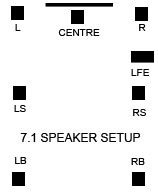Developed by the Digital Theatre Systems Company, DTS was developed for theatre use to play back digitally recorded signals . The digital sound track is recorded not on the film, but is recorded separately on a CD-ROM. A time code is recorded on the film to make playback of sound and image completely automated and in sync. Today DTS amps are affordable for home use with many DVD recorded in DTS as well as the competing Dolby Digital.
 |
|
| Yamaha 7.1-Channel Home Theater Receiver |
Introduced in the movie ‘Jurassic Park’ in 1993, DTS features superior sound quality and reliability, and has expanded to general consumer use.
Consumer-format DTS is basically the same as that for theatre use, but the soundtrack is provided as part of the CD, LD or DVD, A DTS disk looks no different to any other disk. DTS and DTSes is currently the premium format for sound reproduction far superior than Pro-Logic and also slightly better than Dolby Digital.
DTS-ES (Extended Surround) is a newer version of the DTS format, it adds an extra speaker to the rear of your home theatre setup. Called a 6.1 setup it is compatible with the existing 5.1 media. Two variants of DTS-ES exist, one is known as DTS-ES Matrix as it gets the sound for the 6th speaker by matrixing the two rear speakers creating a rear centre speaker channel, While the other version is known as DTS-ES Discrete as it contains a complete 6th channel for the rear centre speaker.
 |
DTS was expanded yet again around the time Blu Ray and HD DVD hit the market, now in a 7.1 format know as DTS-HD Master Audio and DTS-HD High Resolution Audio. The Master Audio version can be described as a lossless audio format where every part of the original studio recording can be reproduced in your home bit for bit. The High Resolution Audio version is not as perfect as the Master Audio version but your ears probably wont pick it. It is often used on Blu-Ray discs where space is limited to fit the Master Audio version. A DTS-HD amp will be compatible with both versions.
Leave a Reply